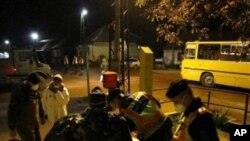An environmental protection group says the wall of a toxic sludge reservoir that burst earlier this week in western Hungary has been leaking for months.
WWF said Saturday the disaster that flooded several towns with toxic waste could have been avoided. The Swiss-based organization said aerial pictures taken in June and published on its website "clearly" show toxic mud leaking from the sludge reservoir.
Listen to Stefan Bos' Report from the Scene of the Toxic Reservoir Flood
WWF's director says the incident points to "neglect" and poor regulation of the facility.
The reservoir burst Monday at the Ajkai Timfoldgyar metals plant, about 160 kilometers west of Budapest. The general manager of the plant told VOA the bursting of the wall was not a "human error." But Hungarian Prime Minister Viktor Orban denied the manager's claim. Mr. Orban said the responsible party will be punished to the fullest extent of the law.
Earlier Saturday, Mr. Orban said the wall of the reservoir that burst Monday is "very likely" to collapse. The prime minister said the reservoir wall is showing visible cracks. He said about 500,000 cubic meters of the corrosive material would be released if the wall falls.
He made the comments Saturday after authorities evacuated Kolontar, which is near the damaged reservoir.
Hungarian officials say the reservoir break released some 700,000 cubic meters of caustic mud.
Interior Minister Sandor Pinter said Friday the escaped sludge has not affected the drinking water supply and is not a threat to the Danube River. However, the environmental group Greenpeace said tests show a high concentration of heavy metals in the sludge and arsenic levels twice as high as what is normally found in aluminum plant runoff.
The sludge has devastated three Hungarian villages west of Budapest, the capital, and has killed seven people. More than 120 people have been injured.
Some information for this report was provided by AP and Reuters.














